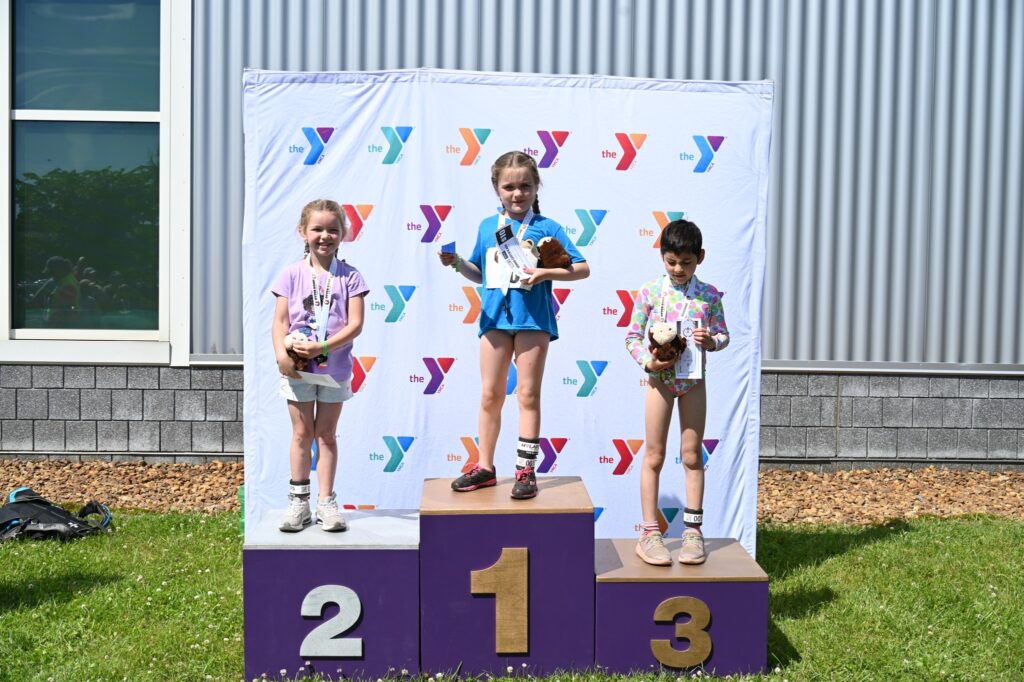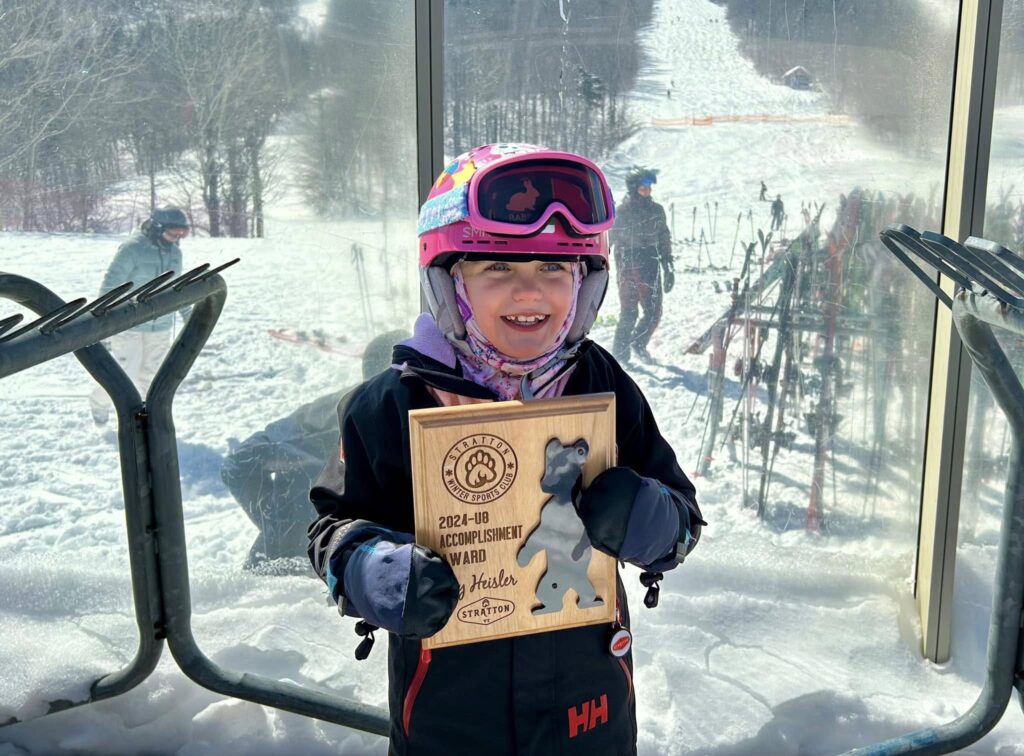5 Tips for Keeping Kids Invested in Sports

For as much as my own athletic performance has declined over the last half decade, it has been a whole lot of fun watching our daughter grow into her own love of sport. It’s a busy series of seasons at the Tundra Division outpost — ski season is about a month away from wrapping up, and then we will transition over to coaching / training / producing our Youth Triathlon. Then it’s swim team, golf lessons, camp, and all the fun that summer can bring.
In other words: it’s a lot, and not just for the kid. It’s a challenge as a parent, and trying to navigate supporting a child’s athletic dreams while also trying to not overwhelm them or put pressure on them to perform. Here are five lessons that we have learned that help support long-term athletic development and help keep them motivated.
The Most Important Thing is Fun
This seems obvious: to keep kids invested in sport, especially as they are learning, it needs to be fun. And yet, that often feels like an afterthought for so many gym classes, or sports groups, or <insert relatively athletic thing here> these days.
Let’s take an example from the ski team. The team is near the end of its competitive racing season, with two races to wrap things up. Are they running gates? You bet. But they’re also still playing in the terrain park, ripping through glades, and otherwise free skiing a bunch of the time too. There’s two reasons for that. First, those other disciplines in skiing build skill that translates back into the race course. But secondly, it’s because the kids want to be doing it.
If they aren’t having fun, they aren’t going to build skill, or learn, or develop the love for the activity, no matter how much you keep pressing. Heck, I broke my wrist at Stratton two years ago picking Ivy up from practice early as, on that day, she just wasn’t feeling it, and I slipped on black ice on our way down to the locker. Guess we should’ve stayed home that day…
Let Them Be Competitive If They Want to Be

The emphasis on fun doesn’t mean that there also isn’t an emphasis on performance. It’s just not the sole focus — at least, not at this level. Most Olympic governing bodies start putting a firmer emphasis on performance in the 12 to 14 year old age bracket, as advantages of early growth tend to level out and skill takes a greater precedence.
But at these younger ages, if they have the want and the desire to win, give them the freedom to want to do so. It also teaches valuable lessons on behavior when winning, or losing, and how to reset after a disappointing result.
Goal Setting

Like most of us, kids are typically going to relate most with outcome or results-based goals. It’s the most obvious: “I want to win the game,” or “I want to finish on the podium” are common. And just like with adults, the lesson that needs to be learned is that too much of an outcome-based goal is simply not in your control. You can’t dictate who shows up, or how fast they’ll be, or what your bib number is. And heaven forbid a disqualification, or false start, derails a race.
We’ve instead talked a lot about process-based goals; those things in our control that might put us in the place to reach an outcome-based goal, but will still give us plenty of pride and positive impact even if we fail at the outcome-based goal. Whether that is with waking up on time to make it to practice, or working as hard as possible at practices (while still having fun, remember), it helps set the building blocks for success.
Mixing It Up
As mentioned at the outside, our daughter has a full athletic slate. She ski races, swims on two teams, races triathlon, and is starting golf lessons. She’s just horse riding away from expensive girl sport bingo. (If any of you start her on that path, I will find you.) But she also performs in a circus troupe. It’s all about her trying and learning different things, and discovering what her passions are out of them.
From an athletic development standpoint, though, all of these various activities are complimentary to one another. Triathlon training builds into her ski season, while swimming and circus are also helping teach how to move a body through a bunch of motions that may not otherwise be natural. But, most of all, the mixing of activities makes it fun (see how we keep going back to that)?
Wearing the Parent Hat, Not the Coach Hat
If you are a parent that is also doubling as a coach, this is possibly the hardest part of the equation. Ultimately your child is looking for you to be their parent — supportive, loving, and a cheerleader — and not their coach. It’s the old classic about why kids are well behaved while at school or in public and then raise hell at home; it’s because that’s where they feel safe and can process the emotional build-up that has otherwise happened throughout the day. But you also have to be coach, and not show favoritism or preference for one child over another.
Taking our youth triathlon program as an example, the conversation that we have had with Ivy is that, for the two hours of triathlon practice, Mom and Dad are coaches, and have to be treated like coaches: with respect, being a good listener, and having a positive attitude. The second practice is over? The parent hat goes back on, with a focus on helping process how practice went. But, flip side, for ski racing? I’m just Dad. My job there is to build her confidence to be able to talk to her coaches, maintaining a good attitude, and being a good teammate.
Photos: Kelly Burns Gallagher / Ryan Heisler




Plus
The lesson I learned from German ski school with my kids is lots of gummy bears at the appropriate times.
It did remind me of my little swimming lesson days where the instructors would toss a goldfish cracker in the pool for us. I can still taste those salty soggy bits!
I still remember to this day. There was a kids race at the Richmond Nascar track that also had elite development racing after the kids race. One of my little 10 year olds swam faster and ran faster but was on a MTB that was slow and clunky vs a 10 year old kid on a tricked out bike with zipp wheels. My guy is upset, and the national team coach fur US at the time comes up to him and says “dude your the better athlete, have fun with it, and get to the point in the sport where equipment choices really matters”.
I tend to think that little conversation was more for the parents then it was for him, but the rest of the weekend everyone had a lot more fun.
That was a fun 2 year experience swim bike and running at that nascar track from youth all the way up to AG’ers.
That the old Rev3 Rush event? Still remember attempting to build that pool in the parking lot in Manassas. Fun times. We only messed it up four or five times before figuring out how to do it…
It’s much the same for skiing; at U10 you start seeing kids moving to many multiples of skis and it does impact results, even though they’re trying to figure out if they like it. I am appreciative that our part of the council prohibits GS suits for U10 racing. But – example – next year, Ivy will probably need new boots, and a minimum of two pairs of skis (all mountain and GS), if not three in the event she outgrows her current multi-event / slalom ski.
In other news, if anybody knows a Rossignol rep…
Yes Rev3 Rush…so many fun memories. The 2nd year I was thinking Endorphine Fitness was going to put all it’s JE’s in the “EDR” races. Turns out they didn’t so I had my only junior racing against basically college aged and above athletes going for their pro cards.
So they announced that the 1st race everyone was going to make it through to the next round. My junior’s shoe fell off at the mount, so the best sportsmanship I’ve ever seen. The entire group was going to lap him out, and they saw he was struggling and didn’t pass him. The way the participant numbers were, everyone made it to the next round (unless you got lapped out). Of course everyone in that race knew me and my team so I thought it was kinda a cool moment, they let the young 16 year old make it to the next round (which he got lapped out in the next round but racing is racing).
Those were 2 good years of memories, I think Charlie told me the cost to rent the track for the weekend and I still haven’t picked up my jaw…so yeah I can see why it only lasted 2 years at that location (was a fun 2 years).
The “mix it up” advice is probably the best as a “recent” kid. The guys I grew up with that played multiple sports were always the most athletic, and seemed to enjoy the sports more than those who specialized year round. The other sports always helped their “main” sport.
As a kid there were multiple times where I wanted to quit sports but my parents wouldn’t let me. I’m glad they didn’t, because team sports taught me so many lessons. It’s a hard line to balance, and I’m both excited and nervous to figure that out myself when (Lord willing) I become a parent.
From a young age our son was a magnet to hockey but he wanted to also engage with other sports including lacosse, running and swimming. It helped him crosstrain and enjoy other sports growing up. Yes he did play both in high school and college hockey but he believed the other sports helped him use other muscles to build a strong foundation. To this day he is enjoys the gifts provided to him.